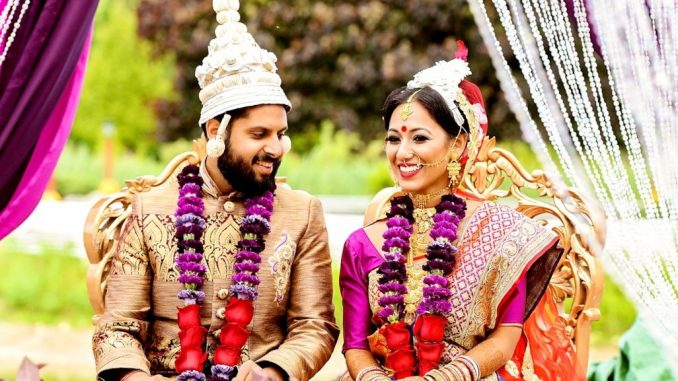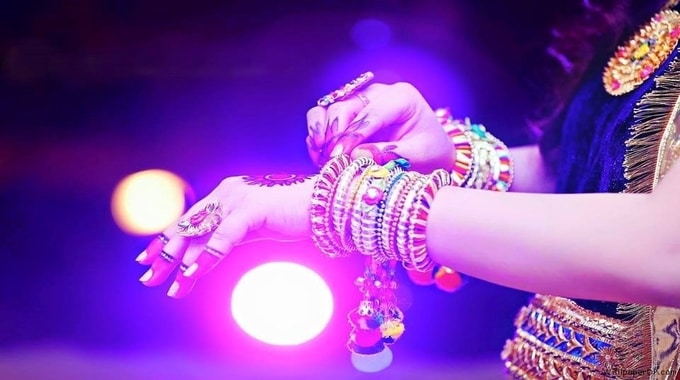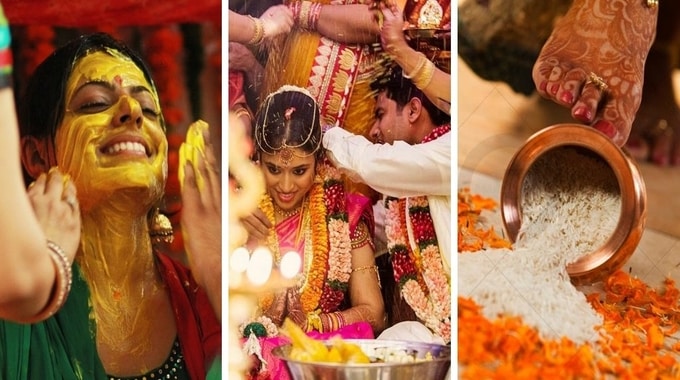
Marriage is known as the sacred bond of love. Husband and wife vow to live together in each other’s happiness and sorrow. With the existence of this relationship, two souls, with two bodies, unite to become “one”. With this, the two families come together and share their feelings with each other. Married rites are called thirteenth among the sixteen rites in Hinduism. After this ceremony is held, a person steps into their marital life.
In Vedic scriptures, a person’s life is divided into four life stages or ashramas. The first ashram is Brahmacharya, where the person focuses on education and good conduct. The second is grihastha (householder), where the person experiences worldly life and the pleasures and sorrows that accompany it. Only during this stage, a person gets married. Next, the third is Vanaprastha, where the original materialist gives up life and the last is the Sanyasi Ashram, which literally means renunciation.
The best of these ashrams is considered to be a householder. It is also mentioned in one verse, “धन्यो गृहस्थाश्रमः / “dhanyo gṛhasthāśramaḥ”, which means that the phase of grihastha (grihastha) is the best among the four ashramas.
Significance of Marriage Ceremony
A man and a woman complete their existence with the help of marriage ceremony and ceremony. This adds to his overall personality. Therefore, marriage is considered an important point of human life. According to the Vedic scriptures, this ritual also frees “Pitru Rin”. Actually, a person is tied to three “debts” or “rinses” at birth. These include “Dev Rin”, “Rishi Rin” and “Pitra Rin”, namely loans to God, teacher and father / ancestors.
Explaining the term marriage or viva, it is a combination of two words, which when defined literally, means to bear responsibility. In Hinduism, husband and wife complete seven chakras around the holy fire under the supervision of the Polar Star and vow to remain faithful and supportive to each other. The main purpose of a wedding ceremony is not only to enjoy material comforts, but also to lay the foundation for a family.

Also Read: Yogas in Vedic astrology and their benefits
That Is Why Marriage Rites Are Important
According to Vedic traditions, a marriage becomes meaningful after conducting the marriage ceremony. The bride and groom’s horoscope is matched according to this ritual. Since childhood, we have been told that marriages are performed in heaven, and its sanctity is undeniable. Hecne’s acting horoscope matching is a way of reuniting the couple into the mortal world. Every native who wishes to marry a good and supportive spouse. But there are examples of arguments, disagreements, and differences of opinion, which can sometimes lead to separation. To avoid such cases, horoscope matching or horoscope matching is done and aspects are matched.
Marriage Muhurat
In Indian society, marriage ceremonies are considered as occasions to perform traditional customs and special gestures. This is why a well-matched marriage brings two families together, but if things do not work out in any case, the situation may be worst. Therefore, according to Hindu traditions, auspicious time or time is calculated before starting any work. Under the same ritual, the bride-groom’s dosh and gunas (aspects) are matched and if all goes well, an auspicious time is calculated for further ceremonies.
What is Vivah Muhurat or Auspicious Time for Marriage?
Marriage is an important ritual in Indian society as described above. Before proceeding, the horoscope of the girl and boy are matched and aspects are calculated. The Vivah Muhurta is analyzed based on the name signs of the bride and groom. There is no specific rule to calculate the auspicious time for the viva rite ritual. Marriage is a lifelong bond, so one should not make hasty decisions. Therefore, go to an experienced astrologer and ask for his guidance while calculating the auspicious time period for marriage.
Relation B/W Marriage Ceremony & Tulsi Vivah
According to Hindu rites and customs, Tulsi marriage is related to Sanskar. It is celebrated exactly one day after Ekadashi in the month of Kartik. On this auspicious day, the basil or basil plant is decorated like a bride. At the same time, the idol of Lord Vishnu is placed as a groom in addition to him. Both are then tied with a silk wire. During these rituals marriage mantras are chanted and sindoor colored rice is offered. Hence the wedding season starts from this day.
Astrological Importance of Marriage Ceremony
According to Vedic astrology, the birth chart of the natives is analyzed to give a prediction of life. The seventh house in the horoscope is an importance of marriage and is rated to learn more about the marital life, spouse and marital opportunities and challenges. for example. If Mars is situated in this house, then Mangal Dosh is formed and the person becomes Manglik. As a result, he may face delays or interruptions in marriage. Therefore, before starting any ritual for marriage, this house is analyzed.
Read Also: What Will Your Love Do With You Behind Your Back | Tarot Reading
Marriage Ceremony Rituals
Tilak
Before starting the ceremony, some important wedding rituals are performed. If both the boy and the girl have approved for marriage, a tilak ceremony is held. It goes by the name “Roka” in the regional language. According to this ritual, the bride’s family performs the tilak of the groom and gives him many gifts.
However, the current trend is exchanging engagement rings before marriage and fixing the wedding. This ceremony basically reinforces the treaty and includes both girl and boy as future companions. Apart from Hinduism, this ceremony is celebrated with love and joy in other religions.
Haldi or Applying Turmeric Paste
In India, the ceremony of applying turmeric paste is organized on the wedding day. It is an obligatory ritual to perform. According to tradition, applying turmeric is considered an auspicious omen, as it is believed that applying its paste enhances the beauty of both bride and groom. From a scientific point of view, turmeric contains antioxidants and enriches the skin. It relieves skin allergies and infections and works as a medicine. On the other hand, it dissipates the negative energy around the house during marriage. Due to these miraculous properties of turmeric, it is believed to have been applied in Hindu marriage ceremonies.
Varmala or Exchanging Garlands
One of the rituals is the exchange of garlands or vermala. It is also called Jayamala. According to the Hindu marriage term, this ritual has been performed since ancient times. It is also described in Hinduism texts as Gandharva Vivah. In ancient times, Swayambara was organized, and one of the most famous Swayambaras that clicks into one’s mind is that of the goddess Sita in the Treta Yuga.
It is well known that when Lord Shri Ram broke the bow named Pinak, only Mother Sita went ahead and put a garland around her neck, which led her to accept him as her husband.
In this ritual, the bride-groom exchanges garlands and accept each other as a life partner.

Also Read: These 4 Zodiac Signs Are Most Likely To Break Your Heart
Pheras or Seven Rounds of Love
Since the rainbow has seven colors, the music has seven notes, seven days a week, similarly the wedding ceremony includes seven rounds or girths. It is considered the most important ritual on the wedding day. That is why these seven circles should be taken around the holy fire to make the marriage ceremony a success. During these rounds, the bride and groom vow to remain in favor of each other under the polar star for seven lives. The following is the meaning of every phera:
- The first round is a symbol of food and nutrition.
- The second round is a symbol of discipline, mental and physical health and strength.
- The third round signifies financial system and wealth.
- The fourth round is a symbol of inner happiness and love.
- The fifth round symbolizes beautiful and noble children.
- The sixth round signifies a peaceful life.
- The seventh round signifies cohabitation and companionship.
Kanya Daan
Kanyadaan is considered the largest “charity” in the whole world. In simple words, the bride’s parents give their daughter to the groom’s family, and this act is called Kanya Daan. According to the Vedas and Puranas, the groom is considered a form of Lord Vishnu. During the ritual of Kanya Dan, the father of the bride is said to have given his daughter away on an assurance that the groom takes good care of her and protects her during difficult times.
- During this ritual, the bride’s parents wash the bride and groom’s feet.
- Then his parents bless his daughter, and
- Wish him well and happiness.
Vidai or Bidding Farewell
The final ceremony during the wedding ceremony is Vidai or Bidding Farewell, which can prove painful for the bride’s side. During this ritual, parents, siblings and relatives share the sorrows of their departure and wish for a better life for their daughter. In addition, the bride sheds tears of farewell and becomes emotional, reminiscing about her childhood and moments. With this, the marriage ceremony ends.
